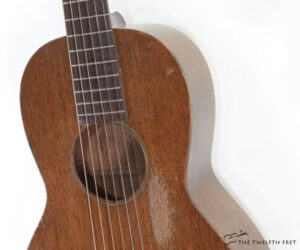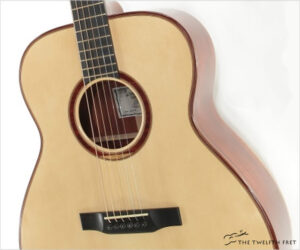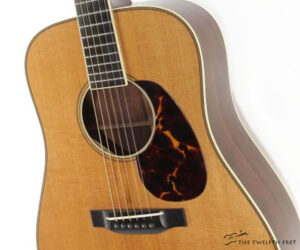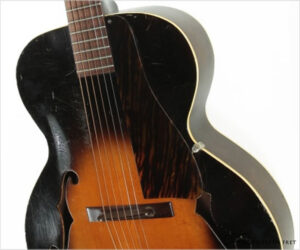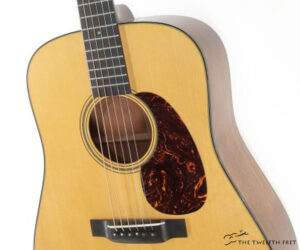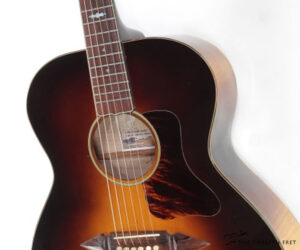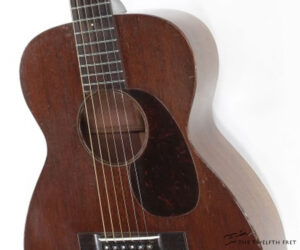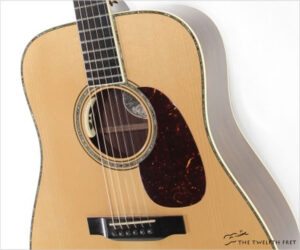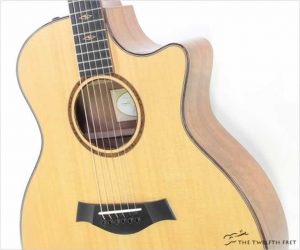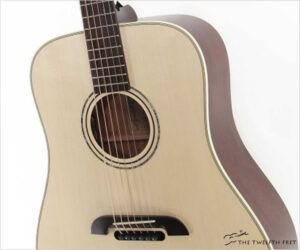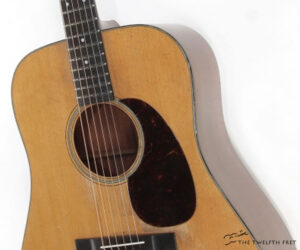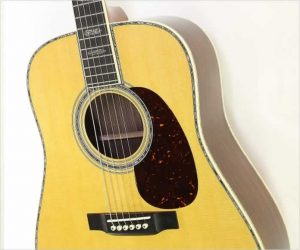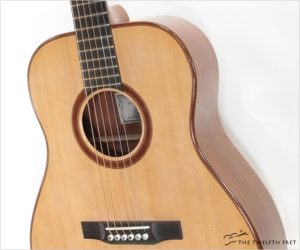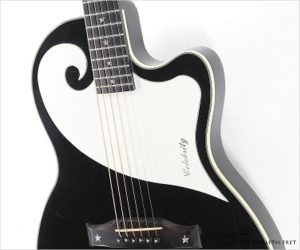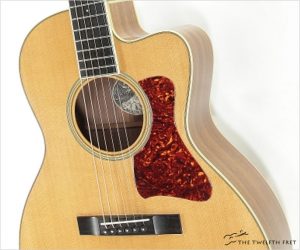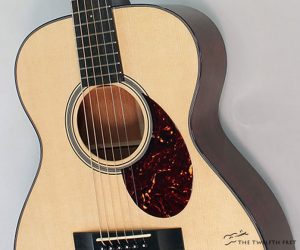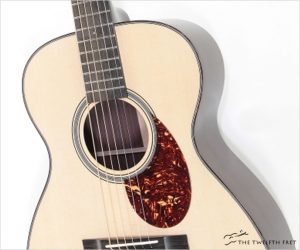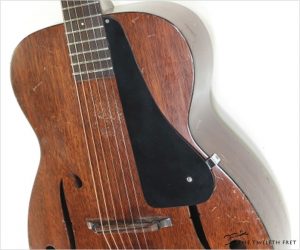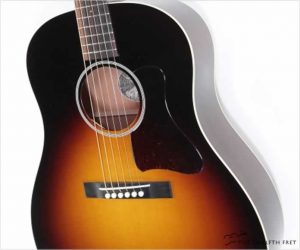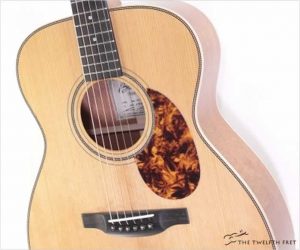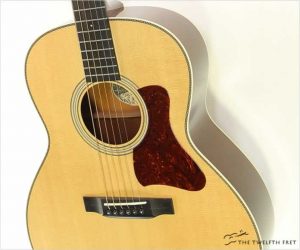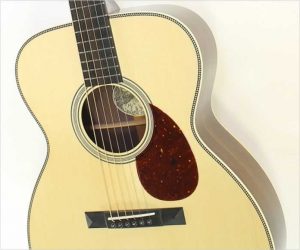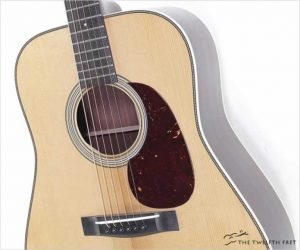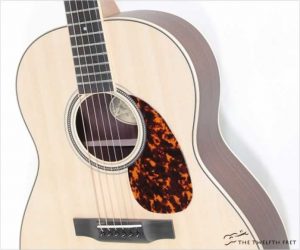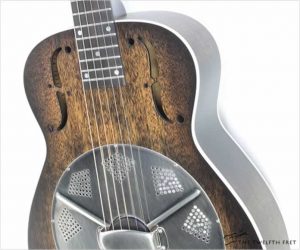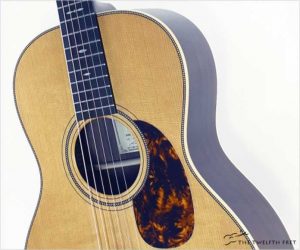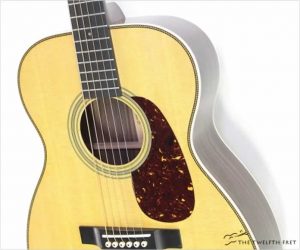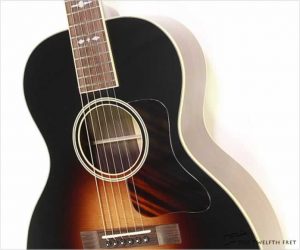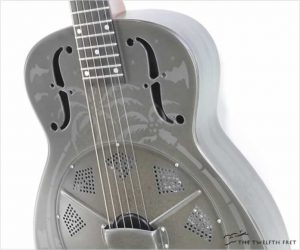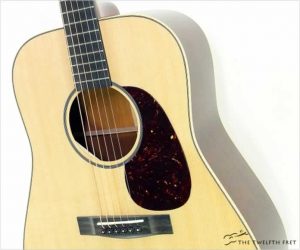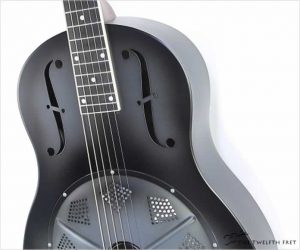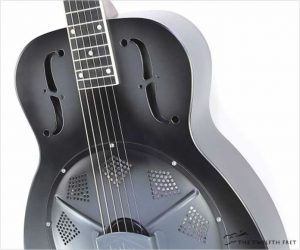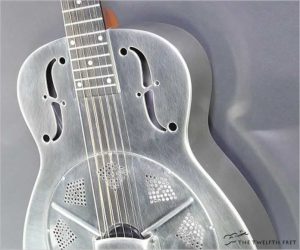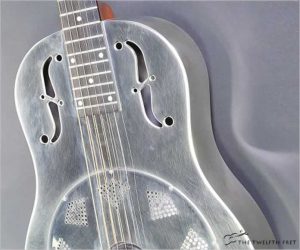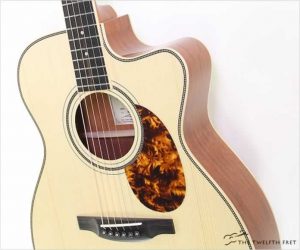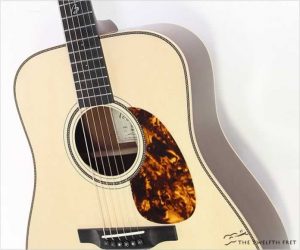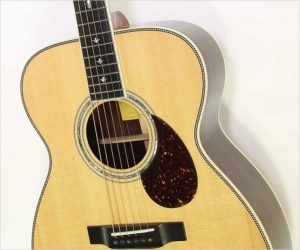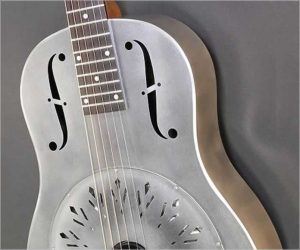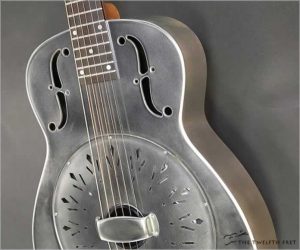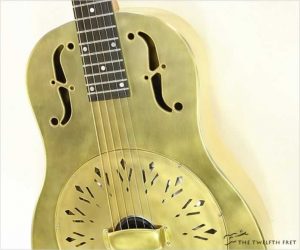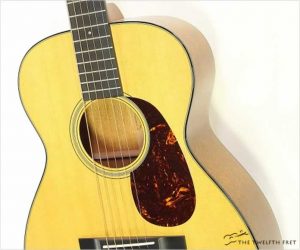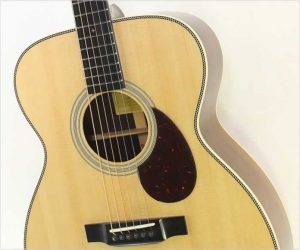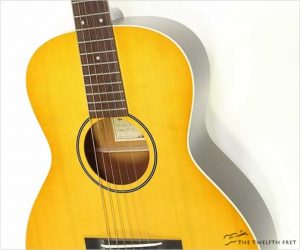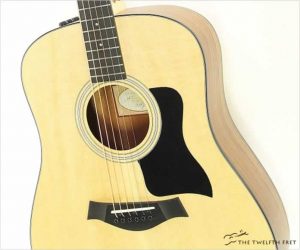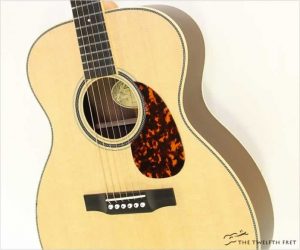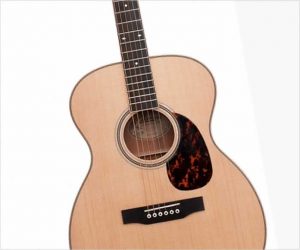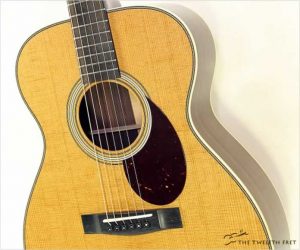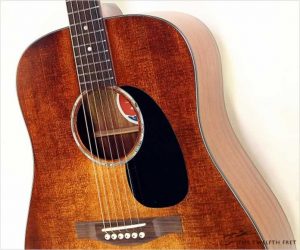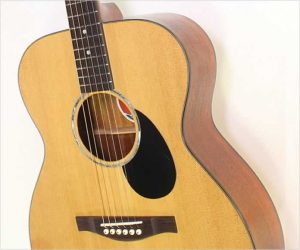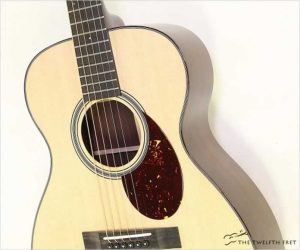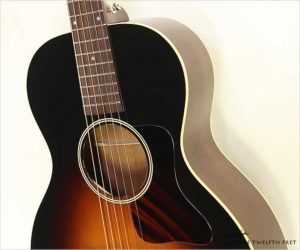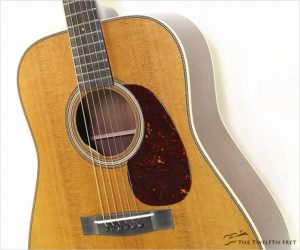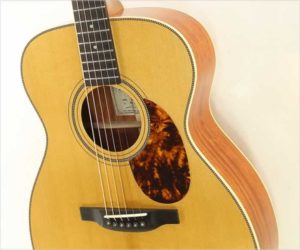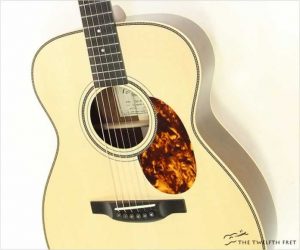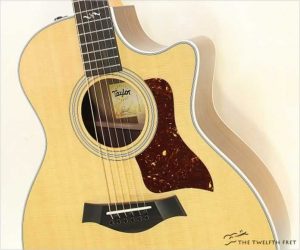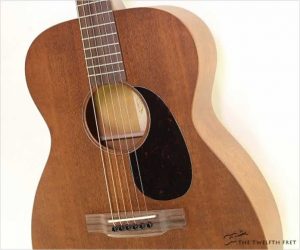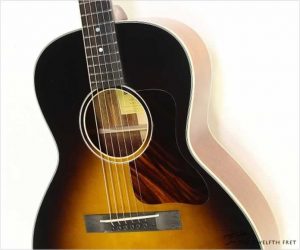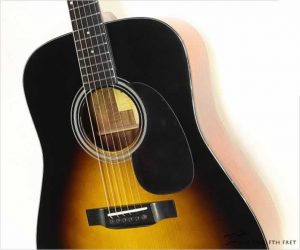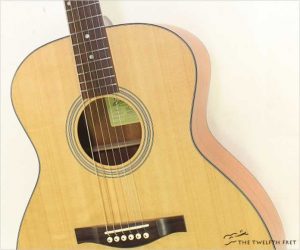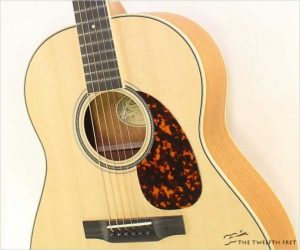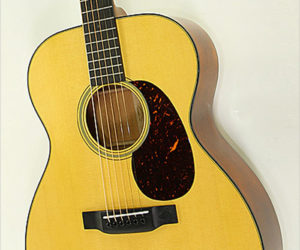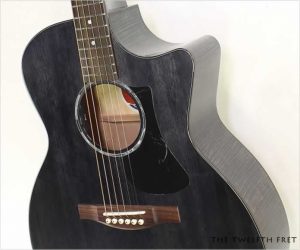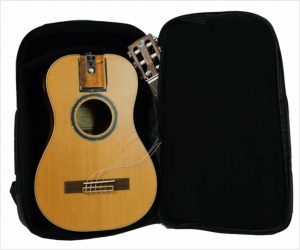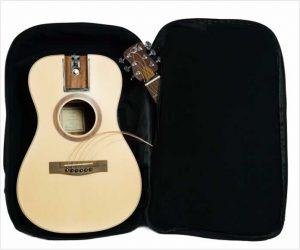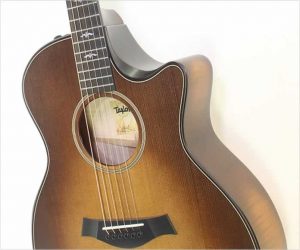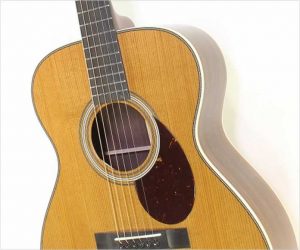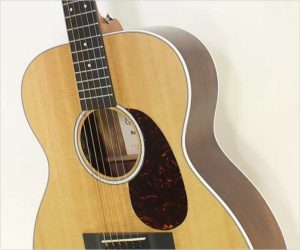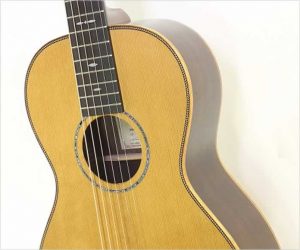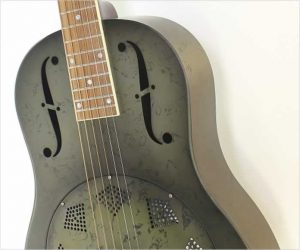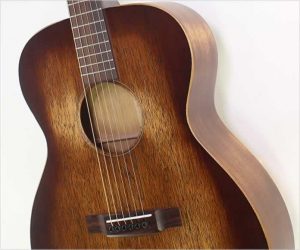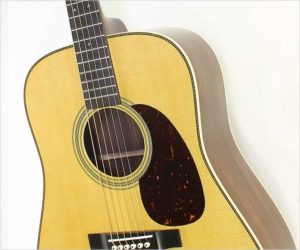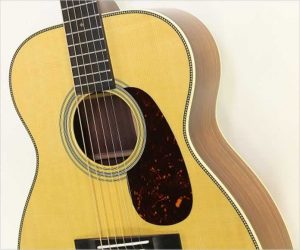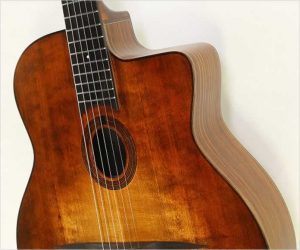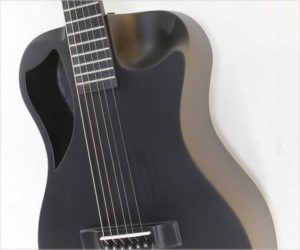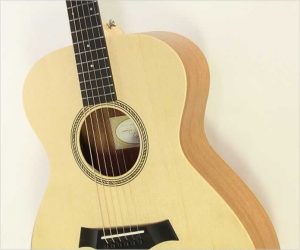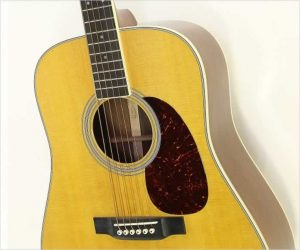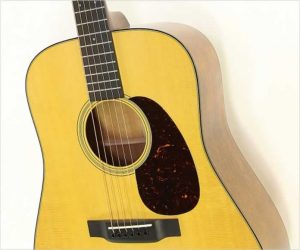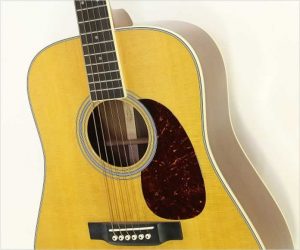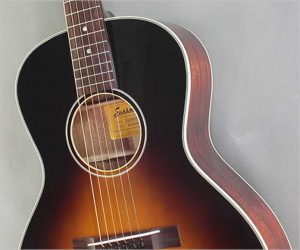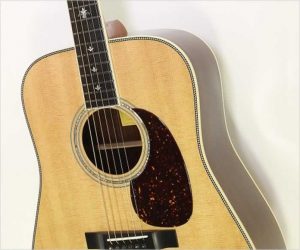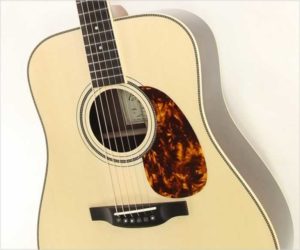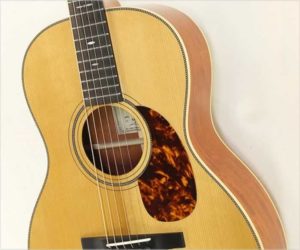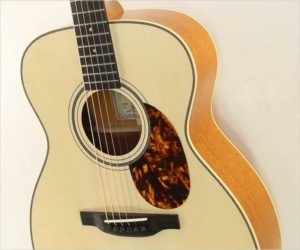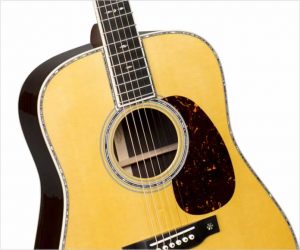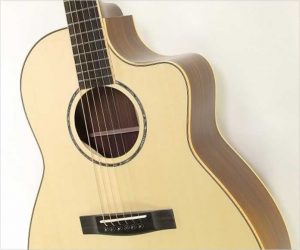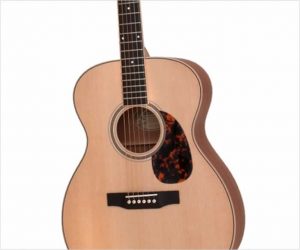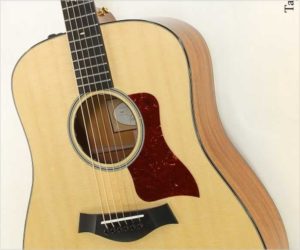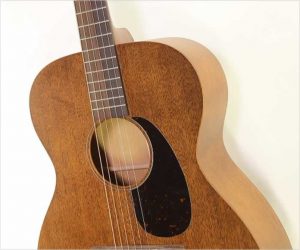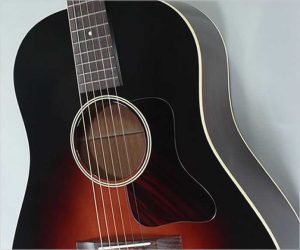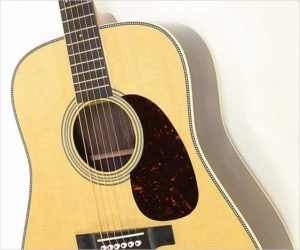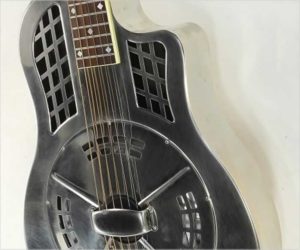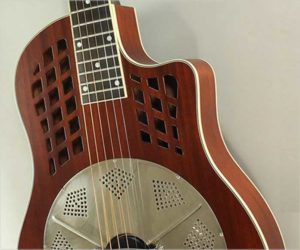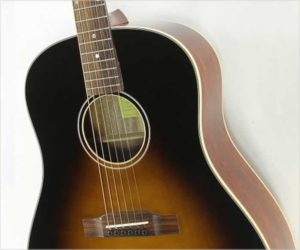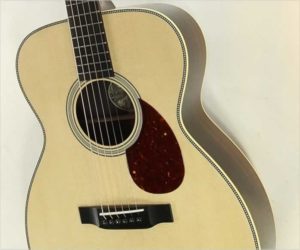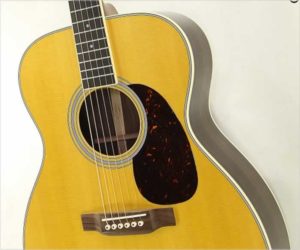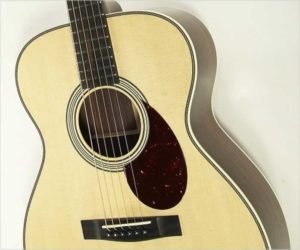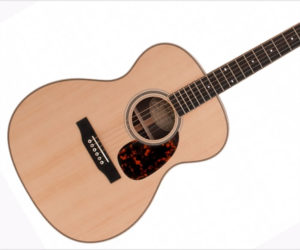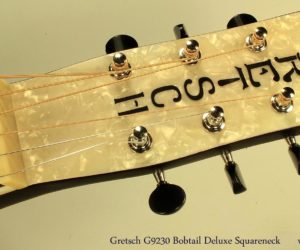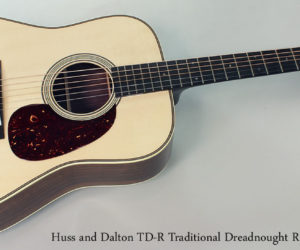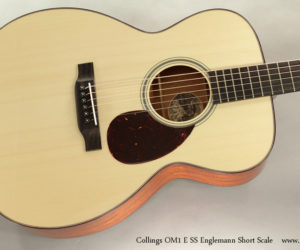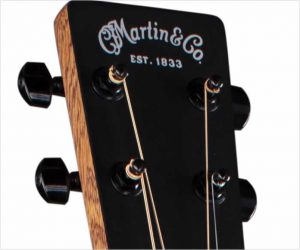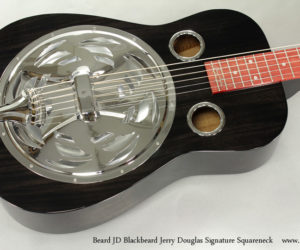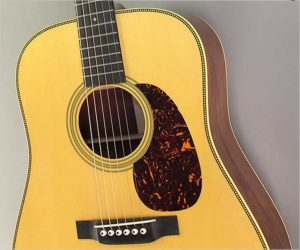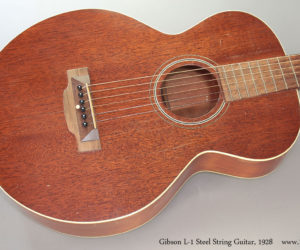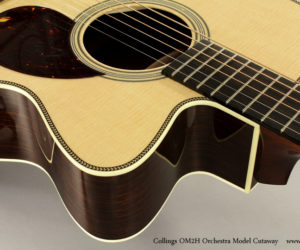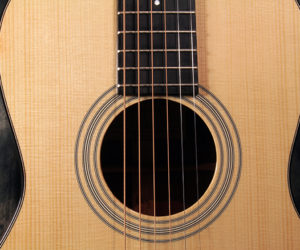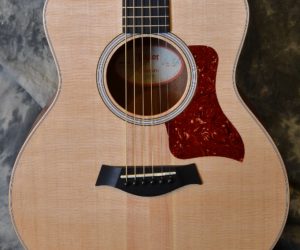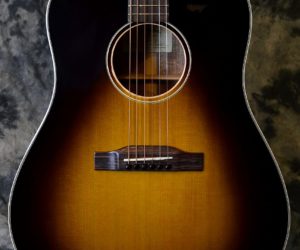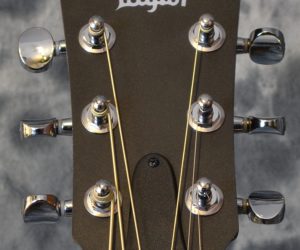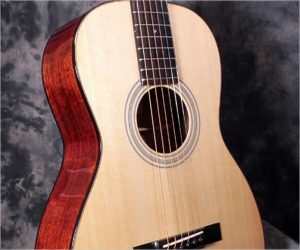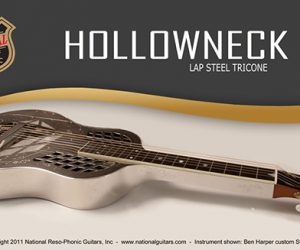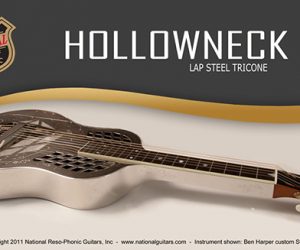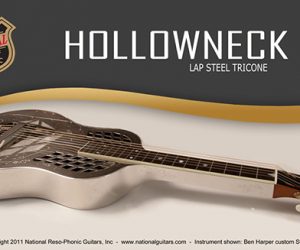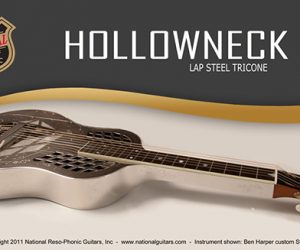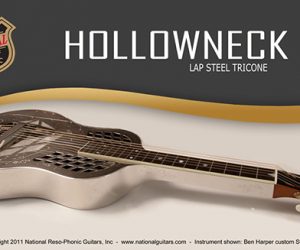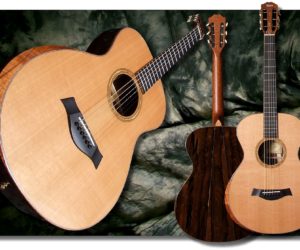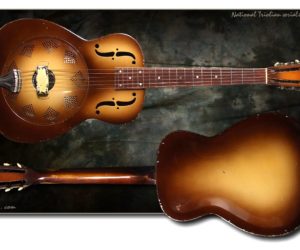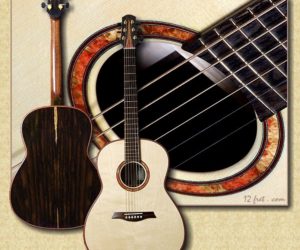Here we’re looking at a Martin 2-17 #25 built during early 1930 in Nazareth, Pennsylvania, showing a 1929 feature – a straight saddle. Not long after this guitar was built, Martin shifted to slanted saddles, giving the bass strings a little more length for intonation purposes. Apparently 449 were built during 1930 with this saddle, and 50 with the slanted saddle.
Acoustic Steel String
This Sergei de Jonge Steel String Guitar pairs a Sitka Spruce top with Padauk for the sides, back, head plate, backstrap and rosette. Built during 2018 in Chelsea Quebec, it is in very good, clean condition, and delivers a full, rich and complex sound. Like many guitars from the de Jonge shops, this model has a French Polish finish, providing protection to the woods with a minimal imposition on the guitar’s vibration.
This spectacular Bourgeois Custom D LSH Large Sound Hole, 2015- is part of a series of instruments offered around the 2015 Summer NAMM show. Dated to June 5, 2015 at Lewiston Maine, this pairs an Adirondack Spruce top with premium Brazilian Rosewood for the sides, back and head plate.
The Cromwell G-4 archtop guitar was built by Gibson from 1935 to 1939 and sold to various retailers and catalog distributors. Inside this guitar, visible through the bass F-hole is a well-preserved yellow label reading ‘New York Band Instrument Company’ indicating that it was sold by that company, at the time a large music store in New York City, but gone by 1950.
Built around February of 2015, this Martin D-18GE 1934 Golden Era Dreadnought sports an Adirondack Spruce top and a Natural finish. Martin’s Golden Era D-18 models were first built during 1995 and based on a 1937 model. From 1999 to 2016, they were based on a 1934 model, and then replaced by the Authentic series.
Here is a rarity! A John Greven Prairie State Model ‘Doug Jones Special’ jumbo steel string from the early 2000’s. This beautiful piece is built with a Spruce top, Flame Maple for the back, sides and neck, and Brazilian Rosewood for the bridge and bound fingerboard. The binding, heel cap, head plate and pickguard are faux tortoise. Tuners are Waverly open gear models with creme plastic buttons.
The Martin 0-17 has at least two major distinctions, as one of Martin’s oldest defined styles, and their first production steel string model. Martin’s Style 17 first appeared in 1874 as a fairly plain model, and was discontinued from 1898 to 1906.
Combining classic D body construction and ’42’ style trim, this 2007 Collings D-42A dreadnought pairs Adirondack Spruce with Indian Rosewood. This sonic cannon delivers much more than good looks and top quality construction. Now out of production, the Collings D-42A sat at the top of Collings’ ‘Traditional’ line.
Here’s a great deal on a New, Old Stock (NOS) Taylor Custom GA in Spruce and Figured Walnut, dating to early 2015 and at a significant price reduction! As the name suggests, the Taylor Custom GA is from Taylor’s Custom programme, sometimes known as BTO or ‘Build To Order’. The GA stands for Grand Auditorium, one of the larger body sizes but smaller than a Jumbo or Dreadnought.
The Alvarez DYM60HDE is based on a guitar designed and built for Jack Pearson, a highly respected American guitarist and once a member of the Allman Brothers Band, and sits at the higher end of the Alvarez line since its introduction around 2018.
Seen here is a wartime (WW2!) Martin D-18 Dreadnought, built during 1943 at Nazareth PA and in great playing condition. Accompanied by a recent appraisal from George Gruhn, this piece is in structurally very good condition with wear expected for over 80 years of use. The back of the head does not have a ‘Made in USA’ stamp, which was typically used to identify guitars built for export, particularly to Canada.
The Martin D-45 has been the top of the line in the Martin Guitar Company’s line of regular production instruments since its initial introduction in 1933, and its re-introduction in 1968.
This de Jonge Standard Spruce and Sapele Steel String guitar with natural French Polish finish is dated to 2021. A lovely, new older stock de Jonge Standard steel string features a Sitka Spruce top with with Sapele (Entandrophragma cylindricum) for the rosette, sides, back and head plate.
The Gibson Chet Atkins Celebrity SST was built from 1991 to 1993 as a version of the CEC – the Chet Atkins Classical, solidbody nylon string guitar.
The Collings C10 Deluxe Cutaway fits into the range of ‘Parlor’ guitars, slightly smaller than the OM or 00/000 body sizes. The cutaway is offered as an option, with the base model being a traditional non-cutaway design. The top and bracing is Sitka Spruce, the sides and back Indian Rosewood, the body blocks and neck are Mahogany and the bridge, head plate and bound fingerboard are all ebony.
The Huss and Dalton T-0014 Traditional 00 14 Fret is a spectacular guitar. The 00 body design is very well balanced and articulate, and wonderful for finger style playing. The Huss and Dalton T-0014 is built with a Sitka spruce top, mahogany back and sides, and ebony for the fingerboard and bridge.
The Huss & Dalton T-OO14 is a fantastic mid-size steel string acoustic guitar, based on the classic ‘OO’ body size. This design dates to 1877 as a 12-fret gut string instrument, and evolving into the steel-string, 14-fret model in 1932 as banjo players moved to guitar.
Listed from 1935 to 1941, the Martin R-17 was one of a few arched top, flat back models in the Martin catalog, featuring a Mahogany top, back and sides. Its sibling, the R-18, had a solid, shaped Spruce top with Mahogany elsewhere; Brazilian Rosewood was used for the head plate, bridge, and fingerboard. Early examples of both models used 12 fret necks but soon gained the more popular 14 fret configuration.
Here we have a brand new and spectacular Collings CJ45 T Slope Shoulder Dreadnought in a sunburst lacquer finish! Based on the classic J-45, the Collings CJ45 T Slope Shoulder Dreadnought takes that design to what’s probably its ultimate expression. Top quality woods and materials are used by extremely skilled workers, and the result is wrapped in one of the consistently best finishes available.
The Boucher SG-41 Studio Goose uses the OM (Orchestra Model) Hybrid body shape, modified to work better with fingerstyle playing. A locally harvested Adirondack Red Spruce top is paired with Brazilian Mahogany to provide clear, crisp tone and immediate response. The neck is South American Mahogany, and Ebony is used for the headplate, fingerboard and bridge. Bindings are Maple with Herringbone purfling.
The Collings C100 is a full size steel string acoustic with ‘Parlor’ type dimensions, providing great representation throughout the sonic range. Available in two versions, the Collings C100 series starts with the model seen here, pairing a Sitka Spruce top with Honduran Mahogany for the sides, back, body blocks and neck. The head plate, fingerboard and bridge are ebony. The Collings logo and position markers are Mother of Pearl.
Here is a brand spankin’ new Collings OM2H ESS – an Orchestra Model with Engelmann Spruce top, 24.875 inch Short Scale guitar. Based on the classic Orchestra Model design developed at the end of the 1920s and in the Martin catalog for 1930, the Collings OM2H ESS is pretty much as good as it gets. Collings quality is consistently very high, from wood selection to nitrocellulose lacquer finish, setup and everything in between. These are some of the finest instruments available anywhere.
The Huss & Dalton TDR is, as the name breaks down, a Traditional Dreadnought design with Rosewood for the sides, back, and head plate. This Huss & Dalton NOS TDR Custom is a New Old Stock model but still covered as new! Built in Staunton, Virginia, the Huss & Dalton TDR evokes the best of the traditional Dreadnought design. Extremely well built and finished, the TDR seen here – a Custom version – uses a Thermo-cured Adirondack Spruce top, paired with Indian Rosewood for the sides and back.
Part of the Larrivee Recording series, the Larrivee L03R is an American made instrument with excellent craftsmanship, tone and value. Back in the early seventies a young Jean-Claude Larrivee created the L body shape which has become a staple of the Larrivee guitar line. This body shape is similar to a classical body design and features a Symmetrical Parabolic X-Bracing pattern.
The National M-14T Thunderbox is the latest version of National’s standard M-14. The newly improved M-14T features a 4″ deep body, improving the low end response and creating a louder, punchier instrument. The National M-14T Thunderbox body is composed of laminate top and back, and solid mahogany sides. This instrument also features a mahogany neck, ebony fretboard and mother-of-pearl position markers.
The Boucher HG56 is crafted for the best tonal results. It will deliver mids and bass depth while finger picking even using a capo at the 7th fret. Evenness and richness of sound will surprise the most accomplished players. The ability of this instrument to adjust to your musical style will elevate your playing to the point of your finding it difficult to put it down. Many fingerstyle players have told us that they feel immediately became better musicians as soon as they played our Heritage Goose. This gives us at Boucher Guitars a great sense of pride to help you accomplish your full musical potential and to boost your creativity.
The Martin 0028 has been built for over a century, with the first known example appearing in 1898. The first mention of the 00 body size dates to 1877! Martin’s 00 body was considered enormous when introduced, and was the largest size until the first 000 sized guitar appeared in 1902, followed a decade later by the D body size built for the Ditson company.
Here we have a Huss & Dalton L-13 Standard in Rosewood, based on the classic Nick Lucas models made by Gibson from 1927 to 1938. The L-13 is part of the Huss & Dalton Crossroads line. Featuring a Sitka Spruce top and here with Indian Rosewood for the sides and back, the Huss & Dalton L-13 Standard is also available with Mahogany for the sides and back, while the L-13 Deluxe uses figured Maple and sunburst on the back as well as the top.
Drawing from the roots of the single-cone resophonic guitar, the National Style O Steel 14 Fret definitely has a vintage appearance with all the quality of modern Nationals. Sporting a unique ‘Weathered Steel’ finish over a steel body with rolled F-holes and a Maple neck with Ebony fingerboard, the Style O Steel 14 Fret delivers all the tone, volume and projection that National is known for.
This is a beautiful brand new Huss & Dalton DM mahogany dreadnought, a great guitar following the traditional pattern of Mahogany D style guitars. Established in 1995, Huss & Dalton began when Jeff Huss and Mark Dalton had the idea to build the guitar they wanted to play. While always appreciating the traditional design, both had a vision of a guitar that paid homage to tradition while incorporating improvements in the structural design and cosmetics of the steel string guitar.
This Michael Messer Blues 14-Fret model is designed by Michael Messer with a special alloy, biscuit-cone for well balanced, authentic Delta-Blues tone and great sustain and volume. Messers have a big, chunky, pre-war style neck which is fitted with a modern fully adjustable truss rod.
The Boucher SG21S comes from Boucher Guitars, who make very high quality hand crafted guitars in the heart of Quebec and their calling card is their use of locally harvested Adirondack Red Spruce. Simple elegance and outstanding quality control are on display when you first observe these fine instruments.
Built in Berthier-sur-Mer Quebec, the Boucher BG152 is a rich, lively and loud dreadnought from the Boucher Bluegrass Goose series of guitars. This impressive dreadnought pairs an AAAA Adirondack Red Spruce top personally selected by Robin Boucher with a lovely set of Madagascar Rosewood. Red Spruce has a high ceiling for tone production which means you can drive a lot of energy with a flat pick or your fingers to produce lots of volume and tone.
The Eastman DT30OM is the second model in Eastman’s new Double Top line, bringing high end classical guitar technology to the steel string world – here in a classic Orchestra Model body design. The double top concept aims to allow a very thin, light and responsive top but with superior strength and stiffness. Here, thin layers of Sitka Spruce are bonded to a honeycomb Nomex core. Nomex is a Kevlar polymer and helps provide significant improvements in stiffness to weight ratios.
The Martin 0-18 Standard is a wonderful addition to the standard series from Martin guitars. This parlor sized body features a Sitka spruce top and mahogany sides and back. The small body shape is extremely comfortable to sit with and compact lower bout width helps to decrease strumming arm fatigue. The mahogany neck has a shorter 24.9” scale length and low oval profile to add to the comfortable playing experience.
The Eastman E8OM features all solid wood construction and a gloss nitrocellulose lacquer finish. The top, with Herringbone purfling, is Sitka Spruce, the sides, back and headplate Indian Rosewood. The body blocks and dovetail-joint neck are Mahogany, with Ebony for the fingerboard and bridge. Unusually, the fingerboard also appears to have a light coat of clear lacquer. The inlays are subtle, small snowflakes in Abalone. The example seen here is strictly acoustic, but it is available with an L R Baggs pickup system.
The Waterloo WLK TR reproduces a rare, lightweight and responsive depression-era guitar built by Gibson under the Kel Kroydon name from 1930 to 1933. These models are built by Collings at their shop in Austin, Texas. An exceptional instrument, the Waterloo WLK TR features a Spruce top and bracing with Mahogany for the back, sides, body blocks and neck, with an Indian Rosewood 12-fret fingerboard and Ebony bridge.
The Taylor 110e dreadnought guitar features a solid Sitka spruce top which is paired with a layered Walnut sides and back. The body size produces lots of volume and punchy midrange with clear trebles from the spruce top. The very stable maple neck has a slightly narrower 1 11/16” nut width and a satin finish which makes for a very comfortable playing experience. If more volume is needed the Taylor 110e is equipped with the Taylor ES pickup system.
The Larrivee OM 40R Legacy is simple and elegant orchestra sized guitar that features a Sitka spruce top and Indian rosewood sides and back. The squared peghead with open gear tuners and bold rope rosette and top purfling enhance this classic aesthetic. Top it all off with the ebony fret board and bridge and maple body binding and you have an excellent looking instrument.
The Larrivee OM-40 Legacy model is a tonally well balanced orchestra size flat top with classic appointments. It features a mahogany back and a sitka spruce top. This tone wood combination provides rich midrange warmth and smooth articulation.
Here we have a new Huss & Dalton TOMR Custom featuring a Thermo-Cured Sitka Spruce top and Indian Rosewood back and sides! The model name breaks down to Traditional Orchestra Model Rosewood. On this guitar, the Custom refers to the choice of the thermo-cured Sitka top; it’s also available with an Adirondack or Red Spruce top, and without the thermo-cure. Thermo-cured wood is also known as baked, torrefied, and by Martin as part of their VTS (vintage tone system). The process uses controlled, high heat, atmospheric pressure and minimal oxygen and simulates aging.
The PCH1 D model from Eastman guitars is an excellent choice for players looking for great sounding guitar at an affordable price. One of the main features on this model is the solid Sitka spruce top. The top or sound board is one of the main components in tone production on an acoustic guitar. While laminate tops have more durability they are stiff and don’t vibrate well. The solid top vibrates with the energy of the strings and produces tone.
The all-new Eastman PCH1 OM model really hits a sweet spot for players looking for upgraded features at an affordable price. One of the main features on this model is the solid Sitka spruce top, paired with a laminate Sapele body. The top or sound board is one of the main components in tone production on an acoustic guitar. While laminate tops have more durability they are stiff and don’t vibrate well. The solid top vibrates with the energy of the strings and produces tone, and its ability to do this develops over time with playing. This is a guitar that will grow with you!
Here’s a beautiful new Huss & Dalton T0014 Rosewood, part of the Traditional series and here seen with a Rosewood rather than Mahogany body. The top of the Huss & Dalton T0014 Rosewood is Sitka Spruce and the neck is Mahogany, with Ebony for the bridge and unbound fingerboard. The headplate is Indian Rosewood, and there are no electronics installed – this guitar is entirely acoustic.
Here is a brand new Huss & Dalton Crossroads 12, a smaller bodied, 12 fret version of the Crossroads line. These “Retro” guitars are great for fingerstyle, particularly blues and folk styles, and work really well with a vocalist. Sold with the original Huss & Dalton hard shell case.
The Huss & Dalton TDR is, as the name breaks down, a Traditional Dreadnought design with Rosewood for the sides, back, and head plate. The Dreadnought design first appeared during 1916, built by C F Martin for the Oliver Ditson company. The design was not popular at the time but when Martin re-introduced it in 1931, times had changed. These models went on to great success and are now one of the handful of standard guitar body shapes, built by almost everyone and played by countless guitarists.
The Boucher Studio Goose SG-21 uses the OM Hybrid, or Orchestra Model body shape modified to work better with fingerstyle playing. The very white, locally harvested Adirondack Red Spruce top is paired with African Bubinga to provide clear, crisp tone and immediate response. The neck is Mahogany, and Ebony is used for the headplate, fingerboard and bridge.
The Boucher SG51 is a hybrid style OM guitar that melds simple yet elegant visuals with an inspiring rich balanced tone. Each AAAA Adirondack red spruce top on the Boucher SG51 guitars is handpicked by Robin Boucher for looks and tone. Red spruce has a high ceiling for tone production which means you can drive a lot of energy with a flat pick or your fingers to produce lots of volume and tone.
The National Style 1.5 Tricone Resophonic guitar is patterned after the original instrument made in 1927 with a functional Art Deco industrial design. It is made of brass, highly polished and plated with either bright nickel plating or a custom Antique Brass treatment! The round, mahogany neck has an ivoroid bound ebony fingerboard. The headstock has the National logo inlayed in mother-of-pearl and vintage-style tuners! To create the National Style 1.5 Tricone, a touch of elegance is added to the Style 1, with hand-engraved double-cut lines encasing a wiggle stroke around the front, side, and back edges of the nickel-plated brass body!
The Taylor 414ce R is built around the popular Grand Auditorium shape which has delighted players with an array of sonic possibilities. This body shape handles everything from light fingerstyle to heavier strumming and flatpicking. The classic wood pairing of Sitka spruce and Indian rosewood used on the Taylor 414ce R provides a complex yet balanced sound.
The C.F. Martin 00-15M model continues the Martin tradition with a 00-14 fret body size, solid all-mahogany construction and a rich satin finish. The Martin 00 body design dates back to 1898 and has been used continually since then. The Martin 00-15M model was introduced in 2009, but Martin has built many mahogany topped guitars in the past, including the 000-18M. Martin’s 15 Series delivers elegant simplicity – a high quality but simply appointed instrument at an affordable price.
The Eastman E10 OOSS is a modern version of a classic – the OO body shape with an Adirondack Spruce top and Mahogany back, sides and neck with Rosewood fingerboard and bridge. This design comes from the 1898 Martin OO18, which was built until 1995, and again since 2006 with a few variations. The OO body is a bit larger and louder than the ‘Parlor Guitar’ size, and closer to the volume of a classical guitar body. These are known as being tonally very well balanced, with good clarity and separation between notes. They make excellent fingerstyle guitars.
The Eastman E10D follows a traditional dreadnought design featuring an Adirondack spruce top paired with mahogany fir the sides, back and neck. Based on the classic square shoulder dreadnoughts introduced to the mass market in the early 1930s and still the basis of many guitar lines, the Eastman E10D gets pretty much everything right. The Adirondack Spruce top produces a full, rich tone that holds up well when played hard, as might frequently happen in a bluegrass context. There’s plenty of bottom, shimmering top end and everything in between.
Now discontinued in favor of a cutaway version with pickups, the Eastman AC122 is a versatile player’s guitar at an affordable price point. Though we can’t resupply this particular model, we have a small number left in stock. The Grand Auditorium style body shape works well for both fingerstyle and strumming. A curvy waist allows the guitar to sit closer to the body when seated and helps to reduce strumming arm fatigue. The warm and dynamic tone is created from the pairing of the solid Sitka spruce top and solid Sapele sides and back.
Part of their recording series, the Larrivee L03 is an American made instrument with excellent craftsmanship, tone and value. Back in the early seventies a young Jean-Claude Larrivee created the L body shape which has become a staple of the Larrivee guitar line. This body shape is similar to a classical body shape and features a Symmetrical Parabolic X-Bracing pattern.
This new redesigned ’18’ models with pre-war features included, including this C. F. Martin 000-18. The 000-18 is one of Martin’s most successful models after its Dreadnought line, and delivers a full, evenly balanced tone ideal for fingerstyle players.
The grand auditorium body used on the Eastman PCH3 GACE is comfortable and versatile, and takes cues from another very popular brand; until recently, many guitars were based on classic Martin and Gibson designs. It performs well for both fingerstyle and strumming and the solid Sitka spruce top has good dynamics and clarity.
The Journey Solid Cedar / Pau Ferro Classical Travel Guitar OC520 is an amazing collapsible acoustic classical travel guitar with solid cedar top and pau ferro layered back and sides, and features a sound port in the upper bout. It’s super ergonomic with the thicker Manzer© wedge and a smaller parlor sized body.
The Journey Travel Guitar in solid Sitka and Mahogany (OF410) – overhead collapsible acoustic travel guitar – features a solid sitka top with layered African mahogany sides/back and collapses to carry-on size! It assembles in 20 seconds with the patented detachable neck system that’s guaranteed for life. A full 24.5 inch scale, a versatile 1 3/4 nut width best-in-class components, and a wedged ergonomic design make this the most enjoyable guitar you’ll ever play!
The Taylor 614ce Builder’s Edition is designed to elevate the acoustic playing experience by providing a luxurious feel and tone. Based around the new V class bracing, the Taylor 614ce Builder’s Edition features a torrefied Sitka spruce top and maple sides and back. The process of roasting the Sitka spruce decreases dampening, which in turn delivers a more played in feel and increased touch sensitivity.
Here’s a brand new Huss & Dalton TOM R Custom traditional OM style guitar, with a custom thermo-cured Adirondack Red Spruce top. This wonderful guitar reflects all the features and quality of Huss & Dalton instruments. Based on the Traditional Orchestra Model or OM design that dates to the late 1920s and using Rosewood for the sides and back, this TOM R Custom also sports a ‘Thermo-Cured’ Adirondack Red Spruce top with Herringbone purfling and a vintage-amber tint.
Here is a new Martin 000-13E Road Series Steel String Guitar, which not only uses a number of sustainable, non-traditional woods, but is also built at Martin’s plant in Navojoa, Sonora Mexico. The Martin Road Series is aimed to be a solid player’s guitar loaded with classic Martin DNA at an affordable price point. The Martin 000-13E is an auditorium sized guitar with a shorter scale length compared to the OM models. This OOO body shape is very comfortable for many players as it features a smaller lower bout and curvy waist. The auditorium body size works really well for fingerstyle playing and light to medium strumming.
Here is a lovely Boucher HG24 M Heritage Goose Parlor 12 Fret Guitar, built with a Torrefied Adirondack Spruce top and Indian Rosewood for the back and sides. Once a dominant guitar design, the Parlor style guitar’s popularity faded along with the banjo and the introduction of Jumbo or Dreadnought body sizes in the early 1930’s. Parlor guitars tend not to be particularly loud, but do offer even, rich tone. As more players become interested in solo finger styles, the Parlor design is becoming more attractive again and builders are offering high-quality takes, such as the Boucher HG54 M.
Part of the 15 series, the new Martin 000-15M Streetmaster is a Mahogany body 000 model with a ‘distressed’ satin finish, no binding, and Katalox, sometimes called ‘Mexican Royal Ebony’ for the fingerboard and bridge. Based closely on the standard series 000 Mahogany models, the new Martin 000-15M Streetmaster uses Mahogany for the top, back, sides, body blocks, and neck. The top and back are braced with Sitka Spruce.
Hopefully this is an indicator of better things – a brand new Martin HD28, delivered to us this week, one of the first shipments from the builder since the shutdown. The Martin HD-28, using the 14 fret D body and pairing a Sitka Spruce top with Indian Rosewood sides and back, is one of the benchmark American guitars. As the D-28 it’s been in production since 1931, and the D-28H indicates that it has Herringbone pattern purfling around the top.
The Martin 00 28 model has been in production, though not continuously, since 1898 and is a mid-sized guitar, between the 0 and 000 or OM body sizes. The ’00’ indicates the body size, while the ’28’ indicates the materials trim and decoration level. Like other ’28’ models, it pairs a Sitka Spruce top with Indian Rosewood for the back, sides and head plate, Mahogany for the body blocks and neck, and Ebony for the fingerboard and bridge.
The Eastman DM1 Gypsy Jazz Style model demonstrates that acoustic guitars do not only follow the pattern of American designs, particularly Martin and Gibson. Here we’re looking at a brand new Eastman DM1 Gypsy Jazz style guitar, in the ‘Petite Bouche’ or small soundhole style. This is a long scale instrument at 26.38 inches or 670mm, almost an inch longer than a typical Martin, and is a fairly large guitar. Construction features a solid Sitka Spruce top with layered Indian for the back and sides.
For as long as musicians have been travelling, portability has been an issue. The Journey Gloss Black Carbon Travel Guitar combines a number of unique features, some patented, to deliver a professional quality guitar in an easily transported package. It comes with its own carry-on luggage! The Journey Gloss Black Carbon Travel Guitar collapses to carry-on size of 22*14*9 inches!
The Taylor Academy A12E is part of the company’s new Academy series of guitars, designed to provide beginners to seasoned players a great playing and sounding instrument at an affordable price point. The Taylor Academy A12E is a compact grand concert sized body which has a tighter waist and smaller lower bout making it a very approachable and easy to handle body size. It has a solid Sitka spruce top and layered Sapele sides and back.
Known for its strong bass response and power, the Martin D-35 is the workingman’s Dreadnought. It features a East Indian Rosewood three-piece back and a Sitka spruce top. The expressive quarter inch straight bracing gives this guitar its signature strong bass response and power, which has made it a popular choice for players such as Johnny Cash and Seth Avett. The mahogany neck has a bound ebony fingerboard and an easy playing modified low oval neck shape. It’s the guitar of choice for bluegrass and folk music. Perfect for the intermediate and advanced player.
The Martin D-18 is the classic, quintessential bluegrass and fingerstyle guitar. It’s got everything needed – balanced tone with deep lows and sparkling highs, clarity and separation, instant response to pick or finger attack, and volume. Today’s Martin D-18 Dreadnought features a sleek, modern low profile for enhanced playability. The D-18 adds a Sitka spruce top to the mahogany back and sides and along with the forward shifted scalloped bracing produces a sound that is warm, punchy and clear. Perfect for the intermediate and advanced player looking for understated looks and timeless tone.
The Martin D-28 is the Dreadnought by which all others are judged. Constructed of solid East Indian rosewood back and sides, Sitka spruce top and mahogany neck, this instrument has been a favorite of artists from Hank Williams Sr. to Jimmy Page.
The Hollowneck Report Part 1 features National ResoPhonic guitars played by Burke Carroll in contemporary Bluegrass tuning, with Chris Bennett on rhythm.
Eastman Strings because we’ve found them to be excellent value. Based on proven designs, Eastman guitars are well built, well finished and deliver tone and playability. Part of the Eastman Strings Traditional series, the Eastman E10OOSS is a small body (00 size) sunburst finished guitar featuring a solid Adirondack Spruce top and solid Mahogany for back, sides and neck, with rosewood for the fingerboard, headplate and bridge. The tuners are open-style with “butter bean” shaped metal buttons.
We’re happy to present the Eastman DT30D Double Top, part of Eastman’s new line of double-top steel string guitars – a technology that till now has mostly been limited to high end classical instruments. The double top concept aims to allow a very thin, light and responsive top but with superior strength and stiffness. Here, thin layers of Sitka Spruce are bonded to a honeycomb Nomex core. Nomex is a Kevlar polymer and helps provide significant improvements in stiffness to weight ratios.
The Boucher Studio Goose SG-52 uses the traditional square shoulder Dreadnought body design pioneered by Martin in the early 20th century, and which has dominated the acoustic guitar world since the 1950s. The very white, locally harvested AAAA grade Adirondack Red Spruce top, using a hand-scalloped forward shifted X brace system is paired with Indian Rosewood to provide warm, full tone. The neck is South American Mahogany, and Ebony is used for the headplate, fingerboard and bridge. Bindings are Maple with Herringbone purfling.
The Boucher Heritage Goose HG-26 is based on the traditional 12 fret, 000 body design, with a slotted peghead to increase string downbearing at the nut without increasing head pitch. This helps add clarity, separation and sustain to open string notes. Here, Boucher has paired the Adirondack Red Spruce with African Bubinga. The neck is Mahogany with Ebony used for the headplate, bridge, and fingerboard.
The Boucher Studio Goose SG-41 uses the OM Hybrid, or Orchestra Model body shape modified to work better with fingerstyle playing. The very white, locally harvested Adirondack Red Spruce top is paired with Brazilian Mahogany to provide clear, crisp tone and immediate response.
The C.F. Martin D-42 features the classic, unmistakable Martin Dreadnought body built with back and sides of premium solid East Indian rosewood and a Sitka spruce top, and is enhanced with vintage appointments found on many Martin pre-war classic guitars. This instrument is highly appointed with pearl inlay and enhanced with vintage appointments, such as antique white binding and open gear tuners .
Here we’re looking at a brand new, just introduced Huss and Dalton CM model. It features an Engelmann Spruce top, Indian Rosewood for the sides and back, with Mahogany for the body blocks and neck. The head plate, bridge, and Maple-bound fingerboard are Ebony. Body binding is also Maple. Abalone is used for the rosette and 12th Fret Scroll inlay, and the Huss and Dalton log is Mother of Pearl.
The Larrivee OM-03 is an acoustic guitar from Larrivee’s Recording Series. This model has a solid Sitka Spruce top with Mahogany back and sides. This OM model has a medium body with full scale length, fitting itself to many styles, particularly fingerpicking.
The Taylor 510E is now discontinued, so this is one of the last ‘as new’ examples you’re likely to find. It is built on the classic Spruce top, Mahogany back and side formula that works so well for fingerstyle and flatpicking. Here, it’s paired with a slotted headstock, which increases downbearing at the nut, and hence open string sustain and separation, without increasing head pitch.
Built with a body and neck of Mahogany paired with Indian Rosewood for the fingerboard, bridge and head plate, the Martin 000-15M is a punchy, responsive guitar. The Martin ’15’ series indicates that the trim level is fairly low, in particular there is no body or fingerboard binding, and the finish is satin. Mahogany has long been used as an alternative wood for guitar and ukulele tops, and Martin has used it for nearly a century.
This new Huss and Dalton DS-12 Crossroads Slope-Shoulder Dreadnought, and it’s an outstanding guitar, showing all the power and richness of the dreadnought design. The slope shoulder dreadnought design first appeared around 1916, built by C. F. Martin with a Ditson brand name, but effectively disappeared in the late 1920’s. Martin started producing square-shouldered dreadnoughts – the classic D series – and the slope shoulder re-appeared as a Gibson design, on models like the J-45.
The National Reso Rocket Steel is one of National’s newly designed single cone guitars, incorporating a redesigned cover plate pattern to complement the distinctive Tricone-style grille work. The Bendaway body has the upper bout cut away for easier access to the higher frets.The Reso Rocket Steel is built with a thin, rubbed steel Bendaway body, paired with a neck made of either Maple or Mahogany and a bound Ebony fingerboard, with Mother of Pearl position markers.
The National Reso-Phonic Reso Rocket Wood Body is a newly designed single resonator cutaway guitar incorporating a redesigned coverplate pattern to complement the distinctive Tricone-style grille work. The upper bout of the wood body has been modified with a deep cutaway for easier access to the higher frets.The very first versions of this innovative guitar were named the ‘Wocket’ and ultimately became the Reso Rocket WB.
The Eastman E10SS evokes the spirit of the classic spruce and mahogany slope shouldered dreadnought guitars popular with countless artists since the late 1930s. This combination of materials and body design delivers a warm, rich tone with plenty of presence and volume. It works very well as an accompaniment to a voice. Starting with the slope-shouldered dreadnought body, the Eastman E10SS pairs an solid Adirondack Spruce top on a solid Mahogany back and side set.
OM’ stands for “Orchestra Model,” but 80 years after this body shape was first designed it has become the most popular 14-fret model with fingerstyle guitar soloists who choose to play on steel strings. Yet flatpickers also find it appealing, and when the graceful cutaway is added these OMs are often used by lead players who routinely explore all 20 frets much as they would on an electric guitar. The compact body shape makes the Collings OM equally easy to handle onstage or when sitting on the couch, and the relatively shallow body (barely over 4 inches deep) results in balanced tone and an immediate response.”
The Martin M-36 uses the fairly new ‘M Body’ design, which using Martin’s ‘O’ sizing is an OOOO, or quadruple O size. Outside of the D Dreadnought and J Jumbo models, this is the largest body Martin uses and it provides a full, even tone with lots of volume.
Classic timeless styling. The Huss & Dalton TOM-R combines traditional flat-top construction with the red spruce bracing used in all Huss & Daltons. This guitar is especially suited for finger-style players or flatpickers with a lighter touch, yet holds up to vigorous strumming when the performance becomes more intense. The even response and airy, shimmery qualities the OM has always been known for are maintained and expanded on in the Huss & Dalton TOM-R.
Here we have a National Resophonic T-14 Cutaway Tricone in a Weathered Steel finish. The official model number is ‘T-14WS’, and it’s a slim, steel bodied, three cone resophonic guitar with a 14-fret neck. And at under eight pounds, it weighs less than many solid body electrics! The T-14 Cutaway Tricone is full-scale guitar, at 25.66 inches. This requires a bit more tension on the strings and the cones, which can result in increased volume.
The Larrivee D-40 Legacy / OM-40 LEGACY series is a revolutionary new guitar from Larrivee. This new model born from years of research and testing features Jean Larrivee’s first new bracing pattern in over 46 years. The new “Scalloped Parabolic Hybrid” bracing system perfectly merges the strength, tonal balance, and clarity of Larrivee bracing, with the Bass response, depth, and volume you’d expect from a vintage dreadnaught.
The Gretsch Bobtail, the G9230, is part of a recently re-introduced affordable acoustic and resonator guitar line, the Roots Collection. It features all mahogany soundwell-type body and neck with a bound Padauk fingerboard, and a dark cherry sunburst finish.
The Twelfth Fret recently become a Huss and Dalton Dealer, and this beautiful new Huss and Dalton TD-R Traditional Dreadnought Rosewood arrived yesterday!
The Collings OM1 ESS Englemann Short Scale doesn’t disappoint in any area. It is about as perfectly built as a guitar can be, with a full, even, rich yet brilliant sound – and this is before it’s been played in at all.
The Twelfth Fret carries and stocks a large number of high-quality guitars, including many new C. F. Martin guitars you won’t presently find anywhere else.
Here it is – the Beard JD Blackbeard Jerry Douglas Signature Squareneck Resophonic Guitar! A cosmetically stripped down version of the Beard Jerry Douglas Signature model, the Beard JD Blackbeard features the E model body built with solid mahogany top, back, sides and neck and a very interesting translucent black finish.
Here we have a C F Martin D-28 Authentic 1937 Steel String Acoustic Guitar. The Martin D-28 Authentic 1937 guitars are based on the most sought after pre-WW2 D-28 models. These instruments have hand-scalloped forward shifted X braces and Adirondack spruce tops. Madagascar Rosewood takes the place of Brazilian rosewood for the back and sides, with traditional mahogany necks and ebony fingerboard and bridge.
1928 Gibson L-1. Mahogany construction. Bridge replaced, original case. This guitar has had a neck reset so the action is quite reasonable.
This Collings OM1 E SS Englemann Short Scale doesn’t disappoint in any of those areas. It is about as perfectly built as a guitar can be, with a full, even, rich yet brilliant sound – and this is before it’s been played in at all. The shorter scale makes it a bit more comfortable and warms up the tone a bit.
It’s always a treat to review a Collings guitar – the build quality is very high, and it’s matched by exceptional tone and playability. The Collings OM2H Orchestra Model Cutaway is based on the proven Orchestra Model body design, also known as the ‘000’ body size, with a cutaway and herringbone binding and backstrip. The OM body size is very comfortable and well balanced.
We’ve just received a new shipment of Eastman guitars, and it included the E10P Mahogany and E20P Rosewood parlor guitars! This great little guitar has adirondack spruce top with scalloped braces, mahogany back and sides (the ’20’ model is rosewood), ebony fingerboard and bridge, bone nut and saddle.
They’re the best selling guitar in our store, and they’re back in stock!
Part of the Traditional Series of guitars from Eastman the E10-SS slope shouldered dreadnought is an excellent tribute to the iconic guitars from the 30’s and 40’s! Inspired by great flat top guitars from the Golden Era of guitar making such as the Gibson J-45, it features an Adirondack spruce top which provides plenty of punch and crisp note fundamentals to complement the warm and sweet midrange of the mahogany back and sides. Top it off with a lovely looking vintage style tobacco burst and you have a guitar that sports a classic look and sound!!
We are proud dealers for Collings Guitars of Austin Texas. We stock around 25-30 guitars and mandolins of their most popular models. We can also special order any custom models.
Small body, Big tone! Based on the big and bold tone of the popular Grand Symphony body shape this guitar is scaled down to be the perfect size for the couch or on the go. This guitar has such a full voice its hard to imagine it coming from such a small, comfortable package. Featuring Taylor’s patented NT neck and optional ES go pickup this modern parlor guitar is built to last, gig ready and so much fun to play it should be illegal!
Here’s an Eastman E10P Mahogany parlor guitar! This great little guitar has adirondack spruce top with scalloped braces, mahogany back and sides, ebony fingerboard and bridge, bone nut and saddle.
In Part 1 of the Hollowneck Report, we took an overview of our project comparing five squareneck National ResoPhonic guitars as bluegrass instruments. In The Hollowneck Report Part 2 we’ll start into the recordings so you can see and hear what they’re really like.
The Hollowneck Report Part 3 features National ResoPhonic guitars played by Burke Carroll in contemporary Bluegrass tuning, with Chris Bennett on rhythm.
The Hollowneck Report Part 3 features National ResoPhonic guitars played by Burke Carroll in contemporary Bluegrass tuning, with Chris Bennett on rhythm.
The Hollowneck Report Part 5 features National ResoPhonic guitars played by Burke Carroll in contemporary Bluegrass tuning, with Chris Bennett on rhythm.
The Hollowneck Report Part 6, our final installment, features National ResoPhonic guitars played by Burke Carroll in contemporary Bluegrass tuning, with Chris Bennett on rhythm.
Taylor’s Build-to-Order program allows any guitar player, anywhere in the world, to design their very own customized ‘dream guitar’, at a fraction of the cost of most custom instruments. Choose your wood sets, body style, inlay package, binding details, and much more. Here at the 12th Fret, many of the Taylor guitars you will see hanging on our walls were designed and ordered through Taylor’s BTO program.
In the late 1920s the Style 1 Tricone was the considered ultimate Hawaiian guitar. The three small cones powered by the Aluminum three footed bridge produce a very different quality of tone than the Single Cone Style 0 guitars
The Martin 000-28 EC Sunburst is based on the guitar Eric Clapton chose for his famous and extremely influential MTV Unplugged performance.
Based on the legendary C.F. Martin Guitar Company D-35 model, the Martin HD-35 features a three-piece back, a bound fingerboard, all wrapped together in Martin’s classic herringbone inlay.
In today’s market, it is relatively easy to find competent builders who have put together instruments with excellent tonewoods, impressive craftsmanship and detail oriented finish work … really good sounding guitars. You have to dig quite a bit deeper to unearth a really inspired creation like this guitar by Sergei de Jonge!
